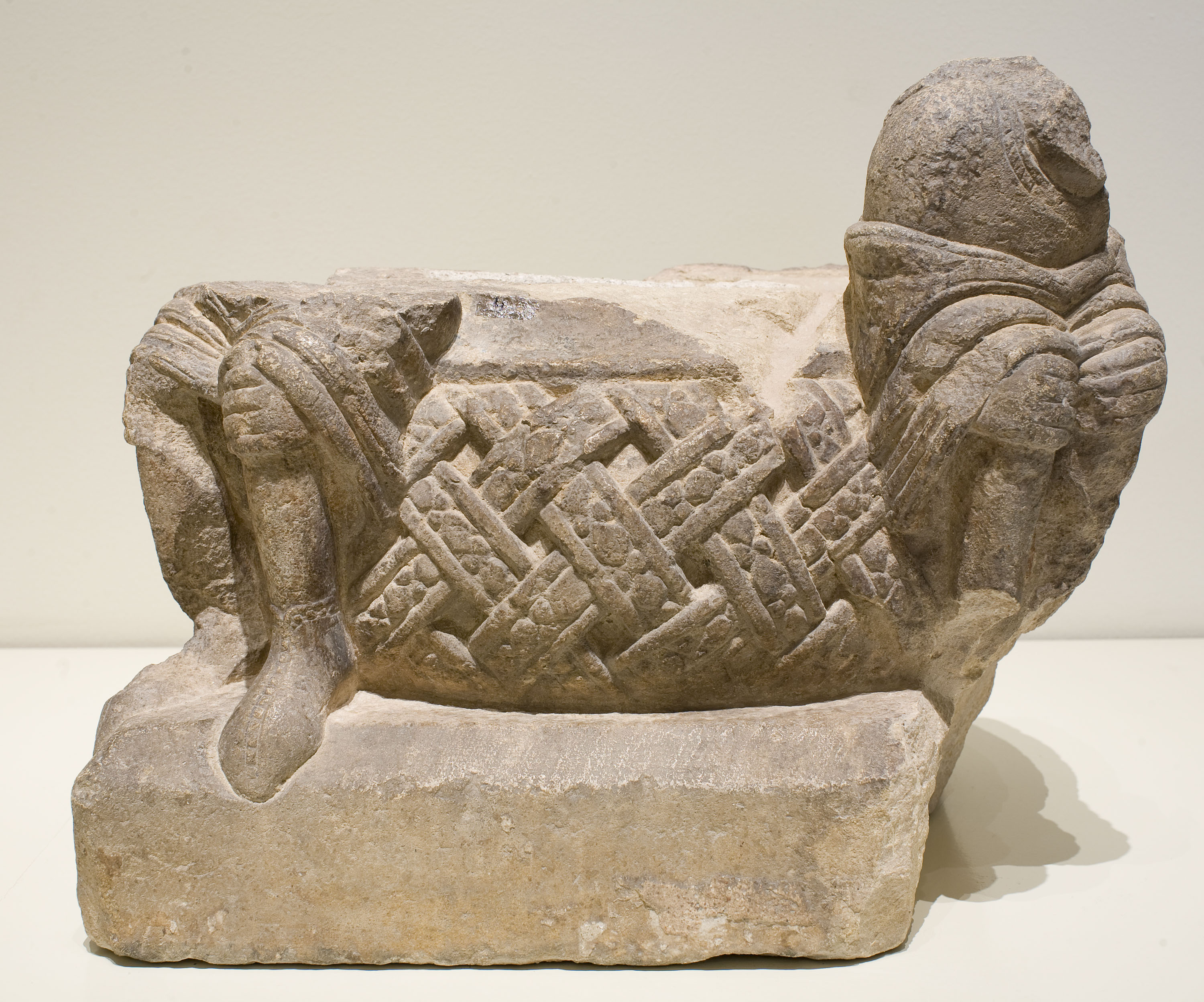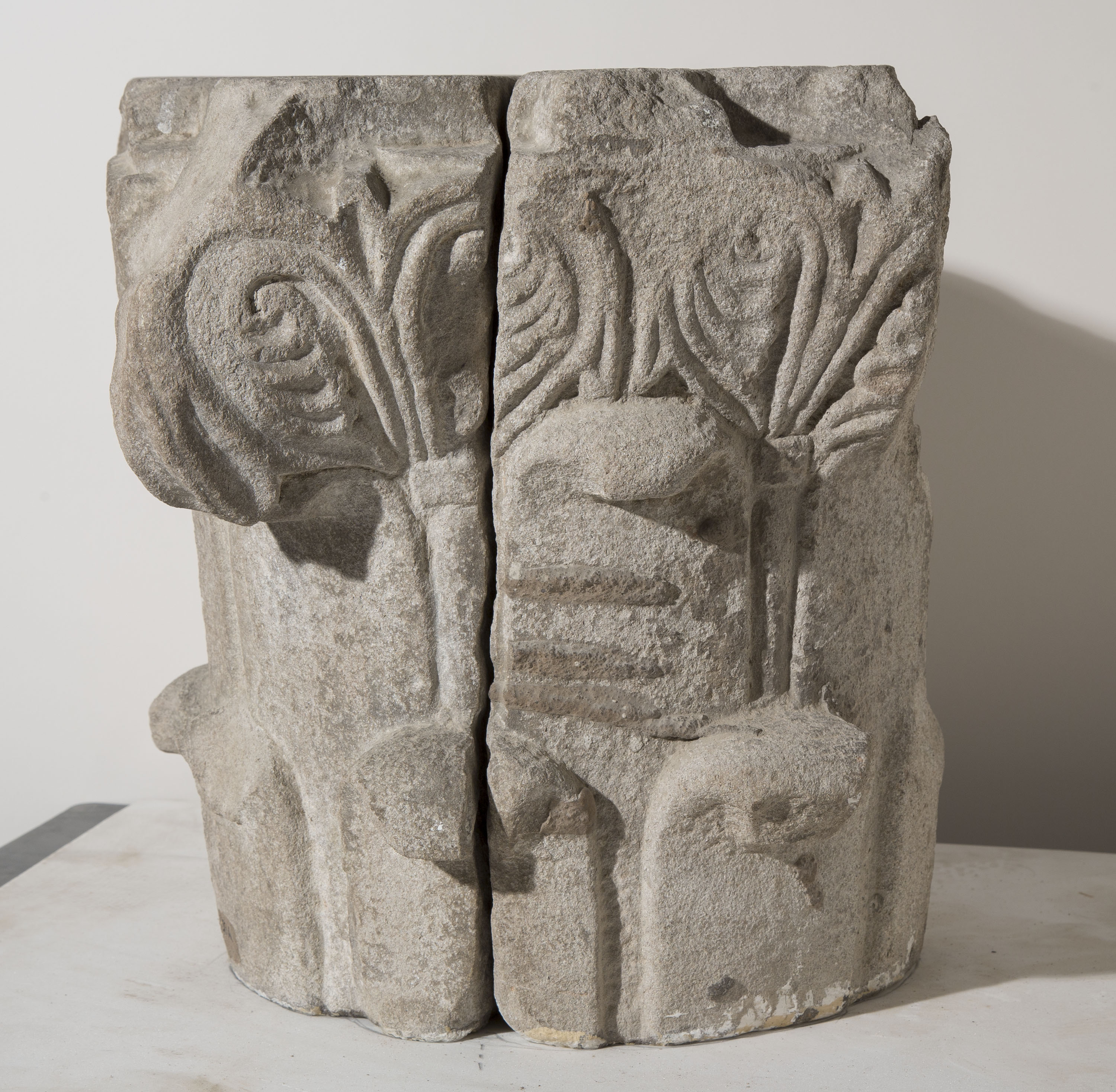Joan Pey
Have you ever seen these four carved stone sculptural bases from the middle third of the 12th century? They belong to the Monastery of Ripoll and are on permanent loan in the Museu Nacional d’Art de Catalunya, exhibited in the Romanesque Art galleries. It has been possible to reunite a lion’s head, which belongs to the Museu Nacional’s collection and was known to be from Ripoll, with the base from which it was separated in the past.

A stainless steel support joins the lion’s head to the body in such a way that it can be detached when necessary (BdV 520.02)
At the end of March 2011 the Museu Nacional received part of the cultural heritage of the Bishopric of Vic on permanent loan, a group of four Romanesque bases from the material at Santa Maria in Ripoll, so that they could be exhibited in the museum’s galleries. It seems, according to some art historians, that they could have been part of the baldachin in the monastery church. One of the conditions of the loan was an exchange of services: the Museu Nacional agreed to undertake to restore these four bases and other works of architectural sculpture that were part of the material from the monastery.
In April 2015 the first addendum to the agreement was signed, by virtue of which the museum was responsible for the restoration of “Abbot Vilaregut’s Sarcophagus”. This restoration is now finished and the work is back in the monastery.
In July 2017 a second addendum was signed, whereby two Romanesque works, a Corinthian capital from the early 11th century and a 12th-century relief with a haloed figure, were temporarily transferred to the museum for the same purpose.
In general, the state of preservation of these works is the consequence of the factors of atmospheric degradation, but above all of the episodes of destruction due to natural causes and acts of vandalism suffered at different times by the Monastery of Santa Maria in Ripoll before it was abandoned. The historical precedents include events of all kinds that ended with the riots that occurred in the first wave of disturbances in the summer of 1835 in the context of the First Carlist war. The disastrous consequences of this pillaging, with very high levels of heritage destruction and the disentailment of the secular orders’ assets, led to the secularization and definitive abandonment of the monastery. Today, the memory of those events is overwhelmingly present through the state of preservation of this depleted example of architectural sculpture that has passed through the museum’s restoration workshops.
Of these works, which until not long ago were preserved in the galleries of the cloister, the bases stand out due to their unique nature. It is believed that they may have been part of a second wooden baldachin covered with silver over the high altar of the basilica, made in the middle third of the 12th century in a period of great artistic vitality. The quality attested to by this small group of surviving elements with differing degrees of mutilation leads us to imagine what must have been a monumental liturgical structure, of extraordinary technical and formal characteristics.
It has been said that the relief with a haloed figure that is currently being studied, and which will be restored during 2018, could also have been part of this baldachin. However, the type of stone it is made of, almost certainly local sandstone, does not correspond to the type used to carve the bases, a lithology equivalent to a type of fossilized limestone slightly ochre in colour; a type very similar to the stone used to sculpt the capitals situated on the bottom level of the cloister in the monastery of Sant Cugat del Vallès, largely 12th century too.
This relief, rectangular in shape, has a drawing of an enthroned figure with a halo holding a book in its right hand. The figure has stayed reasonably intact and the considerable losses of stone affect unimportant parts of the character. In some cases there is a lack of consistency of the minerals in the composition. These small breaks have produced areas with subtle losses, but substantial in volume, on some parts of the face, among others.

Erosion on the figure’s face and breakages of the stone in the top part of the relief (BdV 544_0361)
A Corinthian capital with very interesting characteristics, in the same state, entered the museum together with the relief. This capital was probably part of a known group of 28 eleventh-century capitals discovered in different places in Old Catalonia, Corinthian in composition and to which some authors attribute an influence relating them to that of Andalusian sculpture, which could be an example of the influences of Islamic culture on the Carolingian world in the early Middle Ages. This capital is included in the group of eight units and several fragments of similar characteristics that are now conserved in the monastery in Ripoll.
Restoration work at the Museu Nacional is usually based on the artworks in the collection, but work is also done on pieces that belong to temporary exhibitions and loans, owned privately or by other heritage institutions, when exchange agreements are established benefiting both parties, as in the case of the agreement with the Board of Trustees of the Monastery of Santa Maria in Ripoll.
Enllaços relacionats
Three Romanesque capitals from Sant Miquel de Fluvià identified in the Museu Nacional
Conservador-restaurador de materials inorgànics























